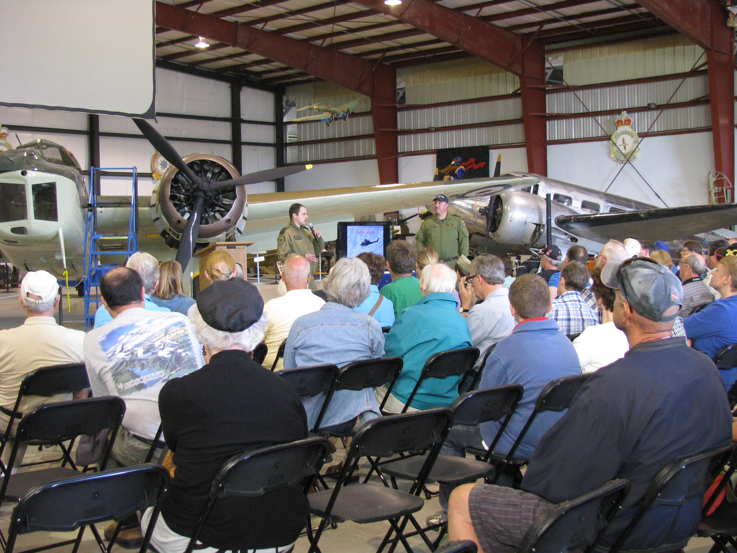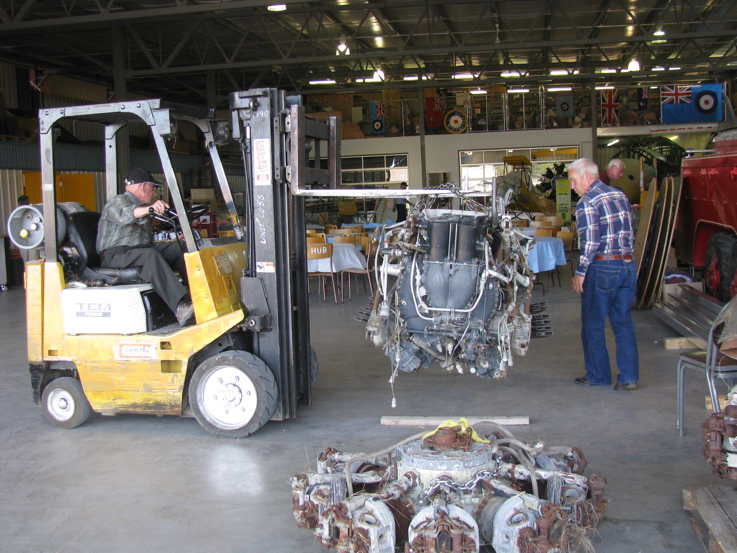 Museum
Museum  |
Bomber Command
|
Aircrew Chronicles
|
Aircrew Losses
|
Nose Art
|
BCATP
|
Lancaster
|
Media
|
Bomber Command
|
Aircrew Chronicles
|
Aircrew Losses
|
Nose Art
|
BCATP
|
Lancaster
|
Media
 Museum
Museum  |
Bomber Command
|
Aircrew Chronicles
|
Aircrew Losses
|
Nose Art
|
BCATP
|
Lancaster
|
Media
|
Bomber Command
|
Aircrew Chronicles
|
Aircrew Losses
|
Nose Art
|
BCATP
|
Lancaster
|
Media
Bomber Command Museum Archived Newsletters
 Download Printable Version
Download Printable Version
On Sunday, May 1, Spiritus Chamber Choir gave a unique performance at the Bomber Command Museum. Surrounded by an incredible array of historic planes, from the famous Snowbird to the museum's centrepiece, the Lancaster Bomber, the performance marked the start of a thrilling month for the choir. Choir Director, Timothy Shantz said, "This is one of the most exciting times in the choir's history, with our first international tour. We were honoured to be invited to participate in the 40th Florilege Vocale de Tours International Choir Competition in France." Performing in Nanton was a way of promoting the choir and giving them a practice prior to going on tour. The performance was enjoyed by all. |
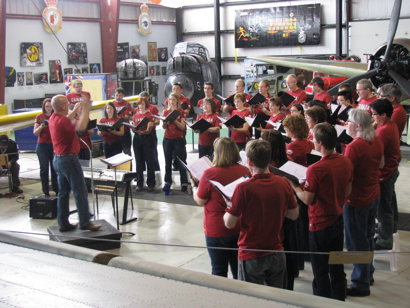
|
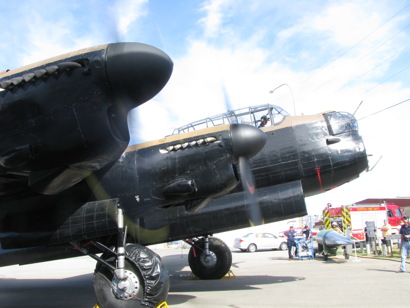 |
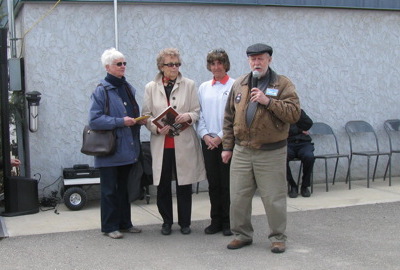 Patsy Parker, and Denny May. Margaret is holding the formed lucky ring which has just been presented by Patsy. |
|
Wayne Bailey continues to work on this aircraft four or five days a week and sometimes more. During the summer the only thing that kept him from working every day was his golf schedule! Also during the summer he volunteered to haul the museum's traveling display to several air shows with his pickup. He has the Beech 18's cabin floor boards made, the cabin stripped, and is painstakingly cleaning up every crevice inside the fuselage with rotary wire brushes and sometimes just plain elbow-grease! Wayne has inventoried the parts on hand and has listed all items that are still needed and is actively looking for sources of missing parts. |
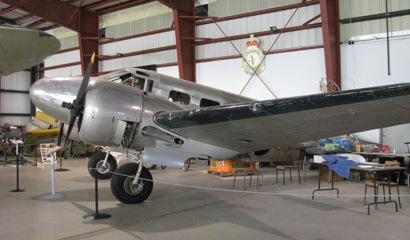 |
On this page are a few photos from this year's event which was very well attended. Added this year to contributing venues was the newly opened Museum of Miniatures. The main hangar of the museum was fully occupied with tables displaying many different types of models, not just aircraft. Former airline pilot and aviation historian and author, Chris Weicht, was on hand with a supply of his books about early Western Canadian aviation history. For those who visited all four venues, plus the many antique stores, it was a full day. |
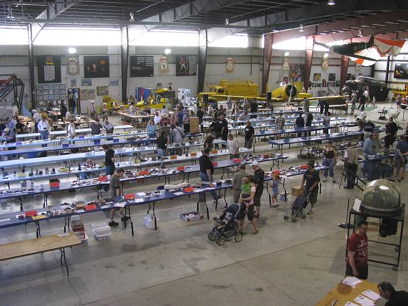 |

|
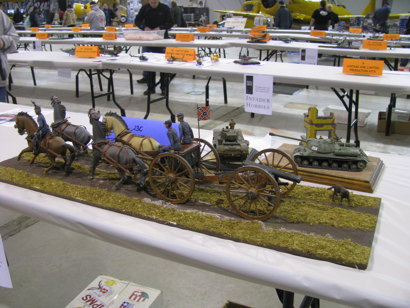
|
|
Southern Alberta rancher, Reid Moynihan, was seven years old when a US Airforce F-106 crashed on his family ranch in June, 1977, in the Alberta foothills killing the young pilot. Reid has kept a monument at the site for 34 years. Reid spent many years searching for answers as to why this happened and in so doing eventually contacted the pilot's family. He had also contacted the Montana National Guard for information. Due to this Chris and Ken Denning, family members of the pilot, Dave Denning, travelled from Montana last summer to the site of the crash on the Moynihan ranch where they placed a headstone. In a ceremony on July 28, at the Bomber Command Museum, members of the Air National Guard presented Reid Moynihan with the Montana National Guard Patriot Medal for the part he played in bringing the story to light thus ensuring that the young US airman, Dave Denning, would be remembered. |
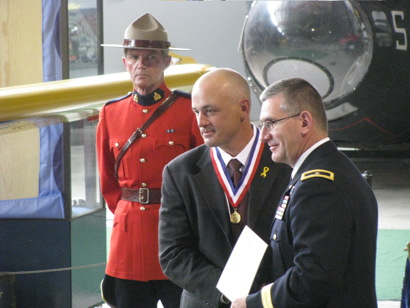 accepts the Montana National Guard Patriot Medal, from Brigadier General John Walsh, of the Montana Natianal Guard, at the July 28 ceremony. Retired RCMP Const. Dennis Muldoon stands by. |
|
A royal Canadian Air Force C-17 Transport landed at Lethbridge, Alberta, on Remembrance Day to pick up 800 pounds of aluminum that was once part of a wartime RCAF Halifax Bomber. The metal will become part of a £6,000,000 Bomber Command Memorial currently under construction in Green Park, London. The aluminum is being provided by the Bomber Command Museum of Canada to draw attention tot the fact that 10,000 of the over 55,000 airmen lost with Bomber Command during World War II were Canadians. Halifax Bomber LW682 was part of 426 Squadron RCAF and was shot down in 1944, crashing into a swamp in Belgium. The seven Canadians and one Briton aboard were killed. The bodies of there of the Canadian airmen, missing in action and entombed in the Halifax bomber, were recovered in 1997 and given a full military funeral in Geraardsbergen, Belgium.  with the special ingots that will become part of the Bomber Command Memorial in London, England. |
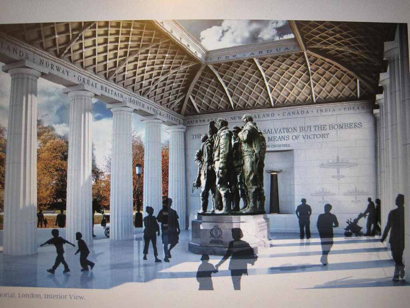 Recovered parts of the Halifax were saved and brought to Canada. Some parts were used in the restoration of the Halifax bomber currently on display at Trenton, Ontario. The unusable aluminum was saved due to the rarity and heritage of this RCAF metal and was melted down into ingots to be used in the future for Air Force Memorials, plaques, and statues by the Bomber Command Museum of Canada. The design of the roof of the 8.5m-tall pavilion was inspired by the geodetic construction used in the Vickers Wellington bomber. This memorial will incorporate the aluminum ingots into the making of the roof panels that cover the Wellington geodetic pattern roof supports The pavilion will house a larger than life sculpture of seven aircrew, carvings and inscriptions. The memorial is to be dedicated June 2012. Interestingly, the RCAF C-17 aircraft that transported this special shipment is part of 429 "Bison" Squadron which flew Halifax Bombers during World War II. |
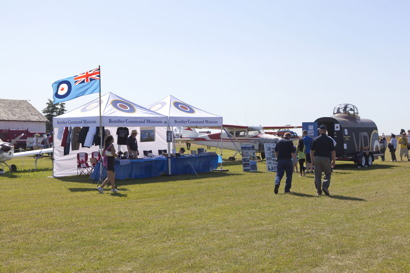
|
Thanks to museum volunteer Wayne Bailey and others, the museum's Travelling Display visited air shows at Cranbrook, B.C., Airdrie, and Lethbridge this summer. Thousands of young and not-so-young people had a chance to operate the integral mid-upper gun turret (with mock-up guns). Those volunteers with the display enjoyed visiting with many of our members and others at these spectacular events. A special thanks to Wayne and all volunteers who accompanied the display.
The museum's display at Airdrie. |
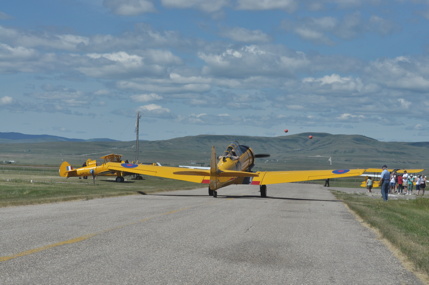 The Vintage Wings Harvard taxiing in after landing at Claresholm as part of the Yellow Wings flight. The Cornell, Stearman and Tiger Moth are parked up ahead. |
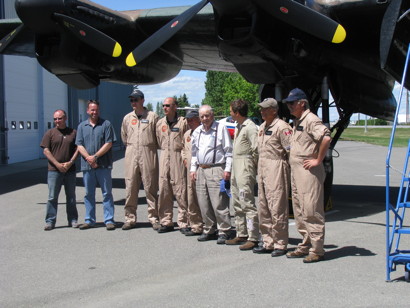 Yellow Wings visitors pose under the wing of the Lanc along with Gordon Jones (fourth from the right). |
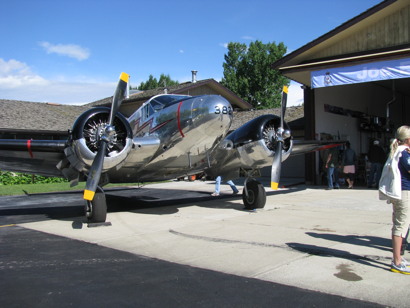 Sun West Aviation's beautifully restored Beech 18, flew in as it has for nearly all the museum's fly-ins over the past decade or so. |
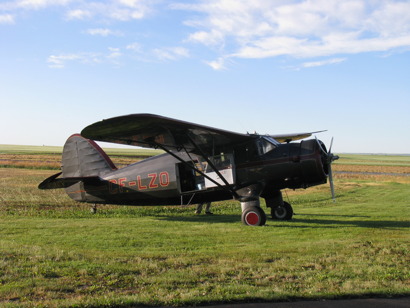 Dennis Mockford arrived the night before the fly-in, in his Noorhuyn Norseman. |
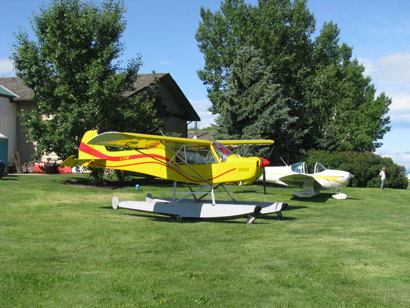
|
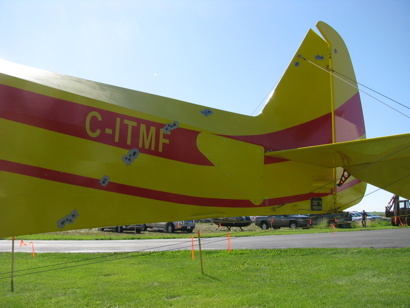
|
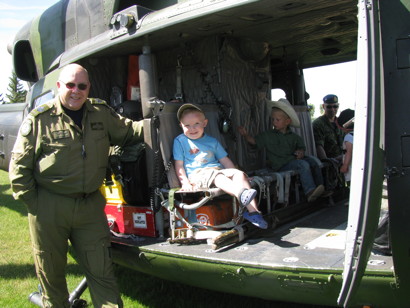
|
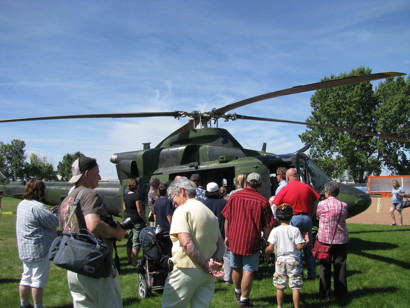
|
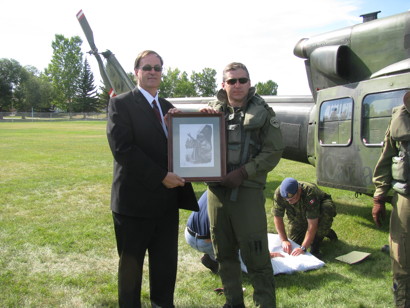 Lt. Col. John Casey presents BCMOC Rob Pedersen with a framed print of a 408 helicopter gunner. |
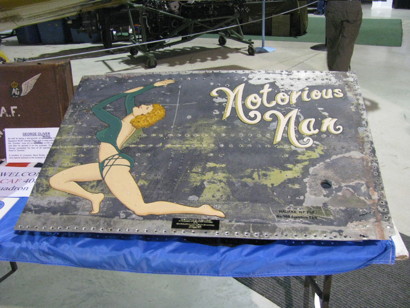 This nose art replica is the work of artist Camina Trsic who donated her talents to produce this replica which was presented to 408 Squadron by museum president Rob Pedersen in recognition of their 70th anniversary. |

 New volunteer, Terry Moynihan is using a jig he made. to laminate a curved fuselage component for the Anson. |
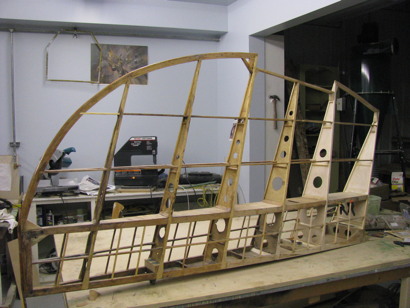 John Maze has the Anson rudder skeleton nearly ready for the final covering. |
 that Fred donated to the museum. |
F/S Fred Sutherland flew as front gunner on the Dams Raid in the Lancaster piloted by F/L Knight. Later in the war on Sept 16, 1943, his bomber was shot down but he evaded and returned to England. On October 21, 2011, Fred delivered five framed, very special limited edition prints that he has donated to the museum. Included are a small print of the Tirpitz by Coulson, and one of Leonard Cheshire's Lancaster entitled, "Limping Home" by Robert Taylor. This print was signed by Leonard Cheshire and Bomber Harris. Another print shows "Dingy" Young's Lancaster bombing the Mohne Dam. This was also a Robert Taylor painting. The prints are presently displayed in the museum library, but will be placed later in a more prominent location. We extend a grateful THANKS to Fred Sutherland for adding to our aviation art collection. |
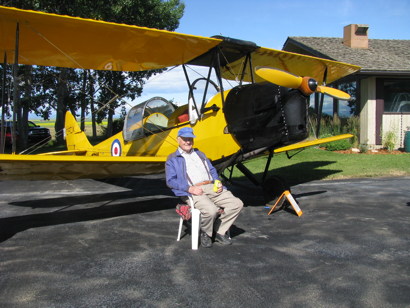
|
The museum has published a number of books over the years and two more are in progress. Available this winter will be, "Big Joe McCarthy -The American Dambuster." As well, we are pleased to report that author Anne Gafiuk had written an article about Gordon Jones, our High River member who is celebrating his Seventieth Anniversary of flying Tiger Moths this year. The article will appear in an up-coming issue of Airforce Magazine. Anne is planning on turning Gordon's story into a book that will be published by the museum. Gordon Jones relaxes in front of his Moth at the museum's July fly-in breakfast. |
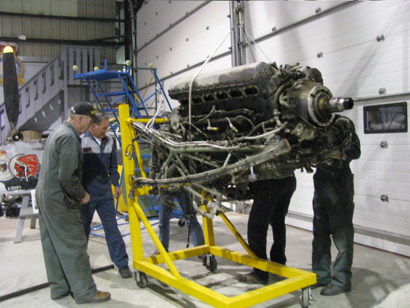
|
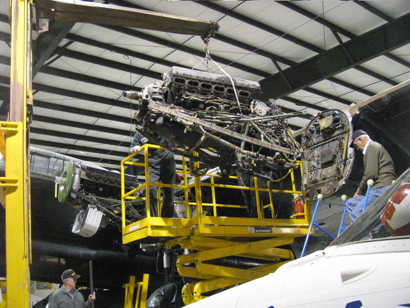
|

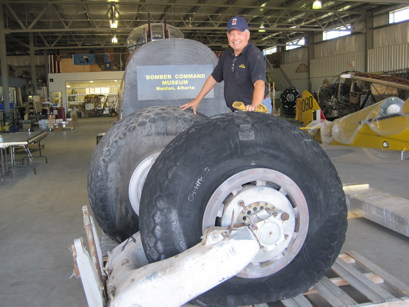 Displayed here are the Hastings/Halifax undercarriages from the island of Malta. |
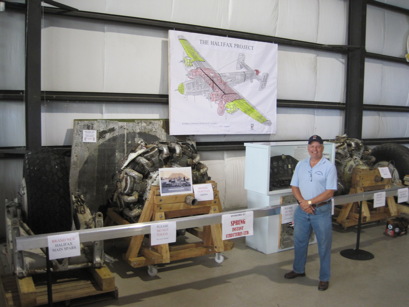 Karl in front of the Halifax display. Note the two Hercules engines from Malta. |
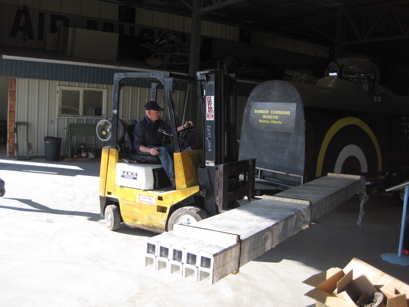 Bob Evans uses a forklift to place new exttruded aluminum beam, made for use in restoring Halifax centre-sections. Sprung Building Industries Ltd., Aldersyde, Alberta hade these made for the project. THANKS to Phil Sprung, his family and employees. |
 One of four Hercules engines complete with rotating stand; more parts in the big box. |
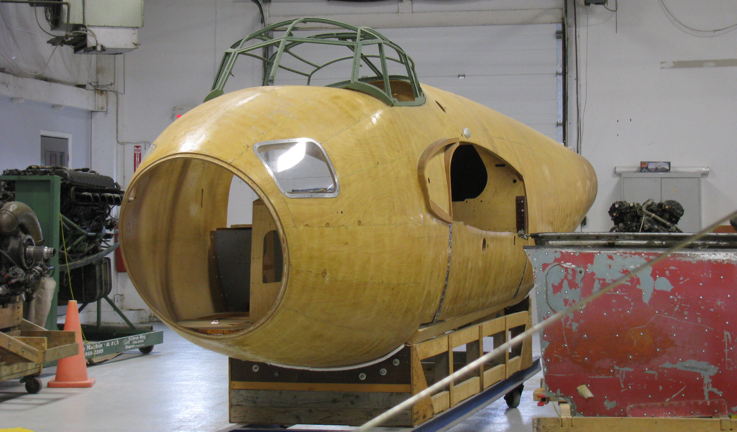
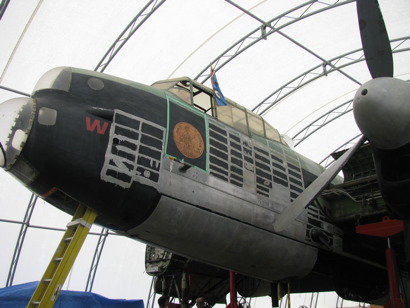
|
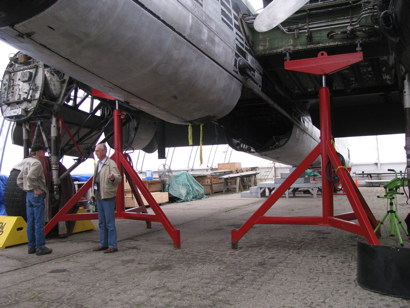
|

|
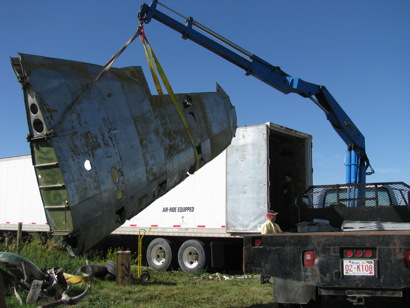 |
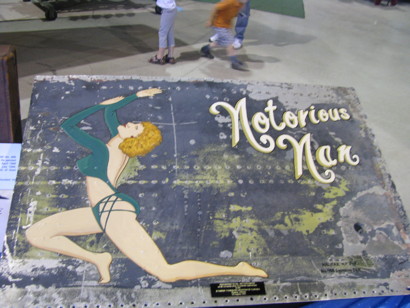 This is the smaller version of "Notorious Nan" reproduced by artist Carmina Trsic. |
 Artist sMike O'Brien's full size reproduction of "Nan" on a Lancaster wing panel. |
 Here all four wings are in the final stage of recovering. They are ready to be painted and have the lettering and roundels applied. |
Early in the year the museum board of directors had contracted with AME Greg Morrison to recover the restored Tiger Moth wings during the past summer. Greg's proposal was more than generous and was a great step forward with this, the museum's only airworthy aircraft project. To date both upper wings and the lower starboard wing are completed, painted with the registration letters and roundels applied. Due to a change in Greg's teaching schedule at SAIT the fourth and last wing has yet to be painted. He hopes to have this done in the near term. This Tiger Moth will likely be exhibited next summer as static display. The engine, while it was major overhauled several years ago, has to be recertified by an approved engine shop. Funds to the tune of about five grand will need to be raised to cover this. |
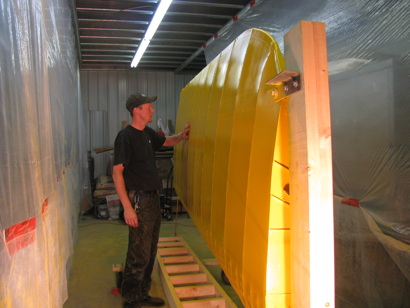 AME Greg Morrison checks out the wing to which he has just applied a coat of paint in the museum's improvised paint booth. |
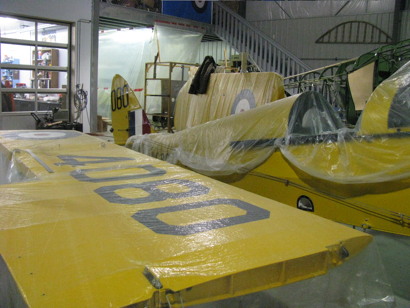 Photo shows the completed starboard lower wing in the foreground and in the rear the two upper wings standing on edge with the fuselage between. As this newsletter goes to print only the port lower wing remains to be painted. |
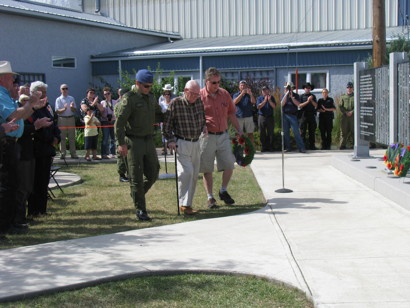 408 Squadron visitor and his son Brian to lay a wreath honouring former comrades who gave their lives. |
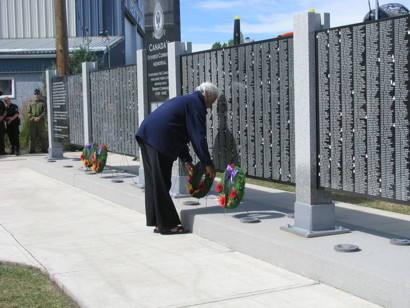 |
